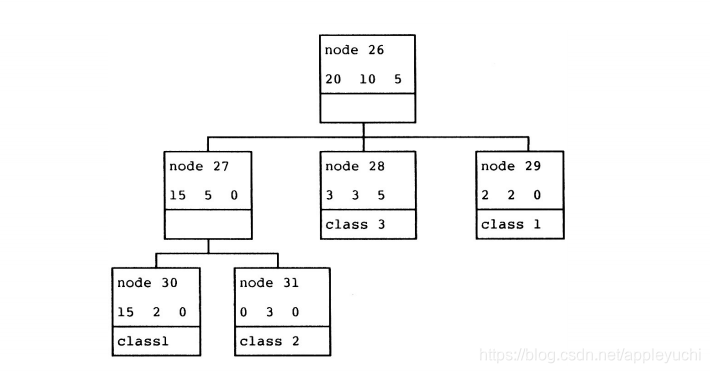Pessimistic Error Pruning example of C4.5
This example is from 《An Empirical Comparison of Pruning Methods
for Decision Tree Induction》

How to read these node and leaves?
For example:
node 30:
15 are classified as “class1”
2 are mis-classified as “class1”
you can reduce the rest nodes or leaves from above
criterion :
where
Be short :
Errors when unpruned<Errors after pruned
when ① is satisfied ,the current tree remains,
otherwise, it will be pruned.
The principle why above Algorithm always take effect
B(n,p)->N( np,np(1-p) )

Picture Reference
:https://stats.stackexchange.com/questions/213966/why-does-the-continuity-correction-say-the-normal-approximation-to-the-binomia/213995
when in reverse,we set a continuity corretion for binomial distribution:
we use “x+0.5” to make these two curse closer(of course this is not accurate enough),then you can use theory of Normal distribution with x+0.5
of course 0.5 is not rigorous,here is just approximation
Why the standard error occur in the criterion?
Let’s see an example:
will fluctuate and Y will fluctuate(I mean they are all variables,Not Constant).
then ,when does Y reach maximum?
Now if we have 4 values Y ever have produced.
1,2,1,1 ②
then average Y̅=
Standard Deviation=
=0.43
so when
Y̅+Standard Deviation=1.25+0.43=1.68≈2.0
Conclusion 1:
All above means that when Y̅+Standard Deviation,we’ll get a value nearest to the maximum in②
------------------------------------------
Let’s come back to Errors we focus just now:
regard Y as the total number of Errors of un-pruned Tree:
Assume(Such Assumption is of course Not rigorous~!):
Y̅=
:Error number of the
leaf
Standard Deviation:
just like the conclusion 1:
means that:
we’ll get a value nearest to the maximum number among possible values of “errors of un-pruned tree”.
Attention please that we assume “errors of un-pruned tree” as a variable,Not constant,
which is used to get the " maximum possible error numbers".
The reason why we call it"pessimistic" is just from
this item means:“pessimistic Error counts”
Note:
There’s a complaint from part2.2.5 of《An Empirical Comparison of Pruning Methods for Decision Tree Induction》for PEP that:
"The statistical justification of this method is somewhat dubious"☺
So the principle of PEP is Not rigorous.
After Principle ,Computation comes:
For pruned-tree,Error counts:
For un-pruned-tree,Error counts:
